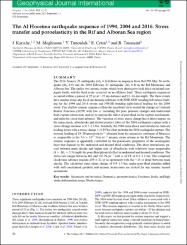| dc.contributor.author | Kariche, J. | |
| dc.contributor.author | Meghraoui, M. | |
| dc.contributor.author | Timoulali, Y. | |
| dc.contributor.author | Çetin, Esra | |
| dc.contributor.author | Toussaint, R. | |
| dc.date.accessioned | 2020-11-20T14:50:42Z | |
| dc.date.available | 2020-11-20T14:50:42Z | |
| dc.date.issued | 2018 | |
| dc.identifier.issn | 0956-540X | |
| dc.identifier.issn | 1365-246X | |
| dc.identifier.uri | https://doi.org/10.1093/gji/ggx385 | |
| dc.identifier.uri | https://hdl.handle.net/20.500.12809/1601 | |
| dc.description | WOS: 000417176000004 | en_US |
| dc.description.abstract | The 2016 January 25 earthquake (M-w 6.3) follows in sequence from the1994 May 26 earthquake (M-w 6.0) and the 2004 February 24 earthquake (M-w 6.4) in the Rif Mountains and Alboran Sea. The earlier two seismic events which were destructive took place on inland conjugate faults, and the third event occurred on an offshore fault. These earthquake sequences occurred within a period of 22 yr at similar to 25 km distance and 11-16-km depth. The three events have similar strike-slip focal mechanism solutions with NNE-SSW trending left-lateral faulting for the 1994 and 2016 events and NW-SE trending right-lateral faulting for the 2004 event. This shallow seismic sequence offers the possibility (i) to model the change in Coulomb Failure Function (Delta CFF with low mu' including the pore pressure change) and understand fault-rupture interaction, and (ii) to analyse the effect of pore fluid on the rupture mechanism, and infer the clock-time advance. The variation of static stress change has a direct impact on the main shock, aftershocks and related positive lobes of the 2004 earthquake rupture with a stress change increase of 0.7-1.1 bar. Similarly, the 2004 main shock and aftershocks indicate loading zones with a stress change (> 0.25 bar) that includes the 2016 earthquake rupture. The tectonic loading of 19-24 nanostrain yr(-1) obtained from the seismicity catalogue of Morocco is comparable to the 5.0 x 10(17) N.m yr(-1) seismic strain release in the Rif Mountains. The seismic sequence is apparently controlled by the poroelastic properties of the seismogenic layer that depend on the undrained and drained fluid conditions. The short interseismic period between main shocks and higher rate of aftershocks with relatively large magnitudes (4 < M-w < 5.5) imply the pore-fluid physical effect in undrained and drained conditions. The stress-rate ranges between 461 and 582 Pa yr(-1) with a Delta CFF of 0.2-1.1 bar. The computed clock-time advance reaches 239 +/- 22 yr in agreement with the similar to 10 yr delay between main shocks. The calculated static stress change of 0.9-1.3 bar, under pore-fluid stimulus added with well-constrained geodetic and seismic strain rates are critical for any seismic hazard assessment. | en_US |
| dc.description.sponsorship | Algerian Ministry of Higher Education and Scientific Research (MESRS); Direction of Research at MESRS; DERCI-CNRS; U-UMR 7516 IPG Strasbourg | en_US |
| dc.description.sponsorship | JK benefits from a scholarship from the Algerian Ministry of Higher Education and Scientific Research (MESRS). The authors wish to thank Nacer Jabour (CNRST Rabat) and Abdelilah Tahayt (University Mohamed V, Rabat) for the access to the seismicity database. We are thankful to Zoe Shipton and Mark Stillings for their comments on an early version of the manuscript, and to Ross Stein and Shinji Toda for sharing the Coulomb 3.4 software. We are grateful to two anonymous reviewers for their contributions in improving an early version of the manuscript. This research programme was funded by the Direction of Research at MESRS and the DERCI-CNRS with INSU-UMR 7516 IPG Strasbourg. Some figures were prepared using the public domain GMT software (Wessel & Smith 1998). | en_US |
| dc.item-language.iso | eng | en_US |
| dc.publisher | Oxford Univ Press | en_US |
| dc.item-rights | info:eu-repo/semantics/openAccess | en_US |
| dc.subject | Seismicity and Tectonics | en_US |
| dc.subject | Dynamics: Seismotectonics | en_US |
| dc.subject | Fractures, Faults, and High Strain Deformation Zones | en_US |
| dc.subject | Neotectonics | en_US |
| dc.title | The Al Hoceima earthquake sequence of 1994, 2004 and 2016: Stress transfer and poroelasticity in the Rif and Alboran Sea region | en_US |
| dc.item-type | article | en_US |
| dc.contributor.department | MÜ, Mühendislik Fakültesi, Jeoloji Mühendisliği Bölümü | en_US |
| dc.contributor.institutionauthor | Çetin, Esra | |
| dc.identifier.doi | 10.1093/gji/ggx385 | |
| dc.identifier.volume | 212 | en_US |
| dc.identifier.issue | 1 | en_US |
| dc.identifier.startpage | 42 | en_US |
| dc.identifier.endpage | 53 | en_US |
| dc.relation.journal | Geophysical Journal International | en_US |
| dc.relation.publicationcategory | Makale - Uluslararası Hakemli Dergi - Kurum Öğretim Elemanı | en_US |


















